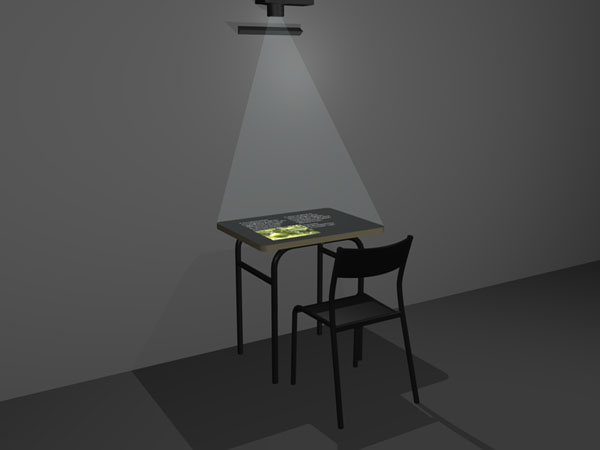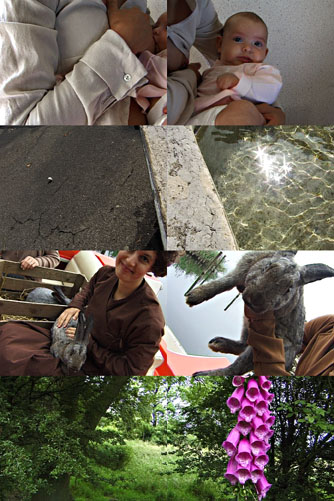|
(1) Flora petrinsularis, CD-ROM, ZKM, 1993; Le billet circulaire, 1997; La deuxième promenade, Le Fresnoy, 1998; Moments de Jean-Jacques Rousseau, CD-ROM, Gallimard, Paris, 2000.
(2) Jean-Jacques Rousseau, Émile et Sophie, “Lettre première,” in Œuvres complètes, Bernard Gagnebin (ed.), Gallimard, Paris, t. IV, p. 905.
(3) Jean-Jacques Rousseau, Art de jouir et autres fragments, in op. cit., t. I, p. 1174.
|
Jean-Louis Boissier : La Morale sensitive (texte en anglais)
Interactive Installation 2001, 2003
As in my previous work, notably my work involving re-readings of Jean-Jacques Rousseau(1), I am investigating in this work articulations between the regimes of reading and spectacle: how do we place cinematographic images onto the pages of a book? Within what I consider to be a new genealogical branch descending from chronophotography, I am looking to preserve the indexical relation inherent in the photographic medium, namely its optical and temporal capturing [saisie]. Thus we find a paradox: to work with interactivity, which belongs in essence to real-time and to a synchrony with the objects it explores, while at the same time using images that refer indexically to a past moment, to the moment itself when the image was shot.

As a consequence, I refuse to allow the spectator-reader to “enter into the image”, while placing him or her in what I consider to be the sole legitimate position: in a relationship with the recording apparatus. A mobile projector can restore the mobility of a mobile camera. An interactive cinema is created by liberating variability within a whole series of parameters that cinematography had to immobilize in order to develop itself into an art. As a result, in the installation La Morale sensitive, the only means of acting on the image is through a simple hand gesture - by displacing the image on the table/screen - therein restoring the lateral panoramic movements within which all of the video sequences were inscribed.
“I told myself that, in fact, we are constantly only beginning, and that there is no other liaison in our existence than the succession of present moments, of which the first is always the actual one.”(2) This notion of the moment borrowed from Rousseau, becomes for me a technical as well as aesthetic entity, a type of suspended spatio-temporal unit, containing neither beginning nor end but instead variations, bifurcations, possibilities of triggering events, and above all repetitions.
Moving from one of these moments to the next, there is not strictly speaking the effect of a visual montage, but rather a stringing of events linked by semantic, thematic and linguistic proximity. This preserves distance, creates a gap -- for, in order to link one sequence to the next, the reader must give his or her “hand” to the program, in other words to the text itself: to the pre-existent and “untouchable” text of Rousseau. It is the text that opens each new image sequence, through a constant play of recalculations of its auto-linking capacities via the play of linking words, or “shifters.”
The text is there to provide a horizon, an argument for a performance of which the interactive video may be considered the report, the account, or more exactly in my case, the capture [la saisie]. With La Morale sensitive I propose through concrete experimentation the hypothesis that an interactivity associated with the shooting process is capable of storing and restoring all palpable forms of interaction captured from reality by the camera, including, and above all, through the logical apparatus of interactivity. All capture or storage [saisie] therefore opens onto a restoration [resaisie]. The dramatis personae, whom I consider as models participating in a performance, are by proxy the vectors of our actions, answering to the reader’s intentions, but also fundamentally escaping them by executing their own acts.
To a Rousseau obsessed with the necessity of proving his loyalty to truth, of proving his innocence, our performances can be seen as attempts to verify the contemporary truth of Rousseau. All of the scenes were filmed at the locations of Rousseau’s life, using models chosen on-site with the intention that the relation-image created by the interactive video produce something other than a simple illustration of the text. It is in this vein that the locations and dates attached to the excerpts are connected to the locations and dates of the images, which are in a sense doubles, but doubles that belong to us fundamentally.
This collision of a multi-layered past into the present of the reading process incidentally finds its model in Rousseau: “In saying to myself, I was overcome with pleasure [j'ai joüi], I am once again overcome with pleasure.”(3) The act of reading has the role of actualizing this past ad libitum, of inscribing it in the permanence of our own time. For La Morale sensitive takes its title from a philosophical project Rousseau never set down in writing, in which he treats the perceptible approach to things through learning and experiment, social behavior and world-view, aspects of which can be found throughout his various writings. According to the “sensitive morals,” we must place our trust in the various registers of sensation and, even more importantly, found our experience on objects and places which, through the permanence of sensations they instill, can guarantee us permanence in our sensations and rationality in our knowledge.
The reader-spectator of the installation, confronted with objects, situations, known gestures and acts, should be able to seize [saisir] -- in other words, literally take as well as understand -- the general model capable of being shared socially with others, while at the same time be able to seize the irreducible singularity of a shot, of its bodies, objects and circumstances. This pseudo-didactic situation is indicated by the usage of schoolroom furniture, a table and a chair intended to evoke in the reader the posture of learning, of an exercise, and perhaps the nostalgia of childhood. Interactivity -- or even, in my opinion, precisely just such an experiment in “interactive cinema” -- is fundamentally appropriate to an autobiographical attitude. Instead of a relation of I to You, it is more a relation of the I of the author to the I of the player. That said, through the choice of the most neutral gestures, through the stress placed on the operations and functions that make up the situations, from the rendering of visual and auditory sensations related to objects, to materials, to the lighting and to atmospheres, through repetitions and the initiative given to the reader-spectator to enact these interactive repetitions, I aim to instill a distance which can be assimilated to the Brechtian Verfremdungseffekt. Our interactive dramatic method consists of placing the reader into a play of relations wherein, if we feel guilty of voyeurism and of manipulation, we always find ourselves rendered innocent at the very point at which, as in Rousseau himself, we able to defer our “guilt” to the circumstances of the game, and to the “advances” made by the machine.
|


